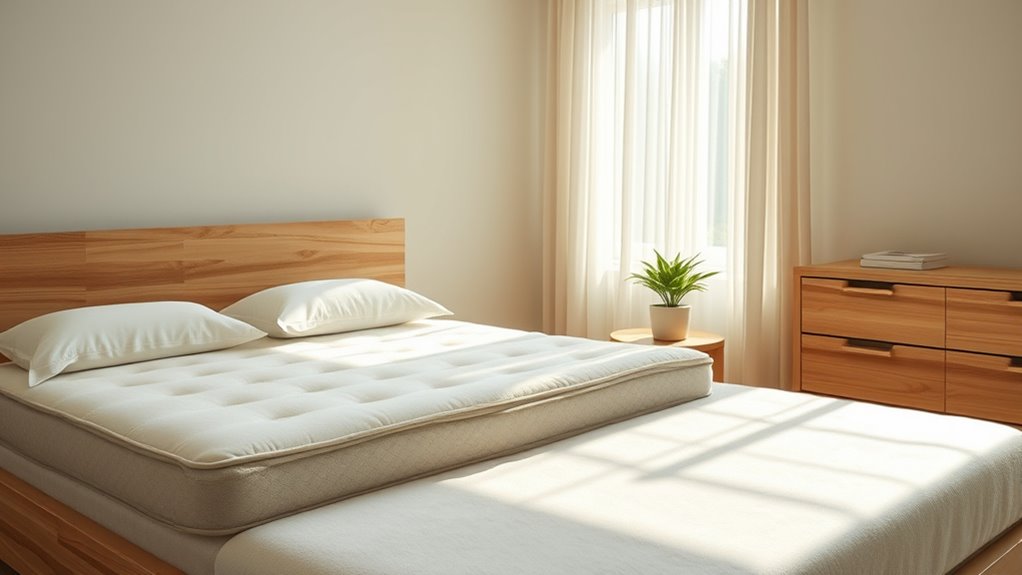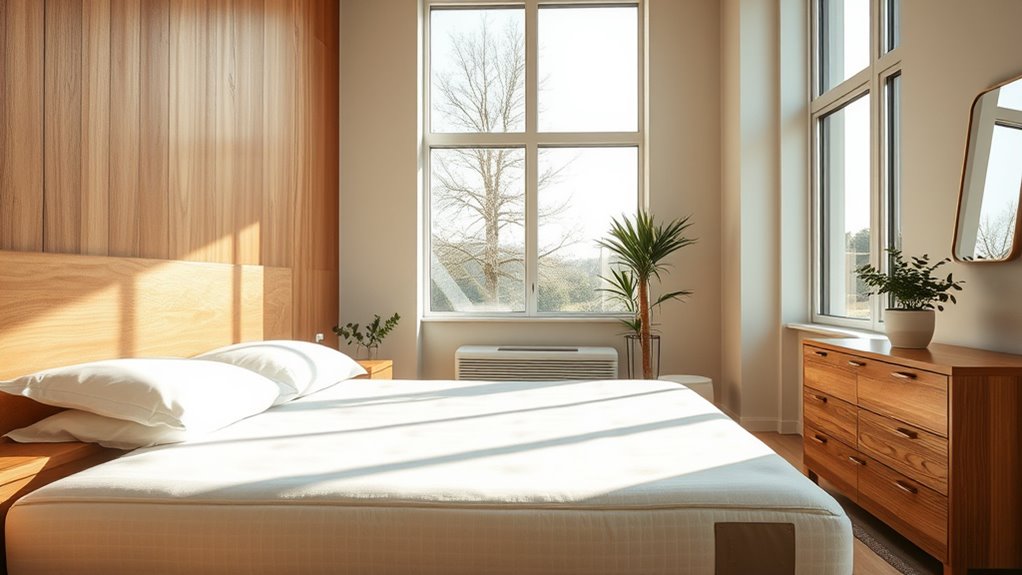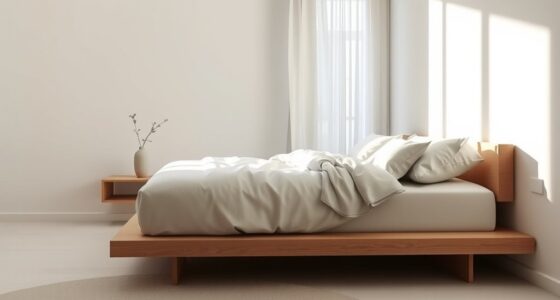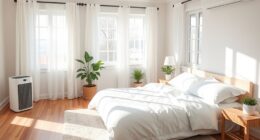To choose non-toxic mattresses and furniture, focus on products with low VOC emissions, certified by labels like GREENGUARD Gold or OEKO-TEX. Opt for natural or organic fabrics, untreated wood, and solid wood furniture, avoiding pressed composites and synthetic materials. Transparency from manufacturers about their sourcing and chemical use is essential. Air out new pieces before bringing them inside to reduce emissions. Keep these tips in mind to create a safer living space and discover more ways to improve indoor air quality.
Key Takeaways
- Choose products certified for low VOC emissions, such as GREENGUARD Gold or OEKO-TEX Standard 100.
- Opt for natural, untreated materials like organic cotton, natural latex, and solid wood furniture.
- Verify brand transparency about sourcing, manufacturing, and chemical treatments.
- Air out new mattresses and furniture before bringing them indoors to reduce initial VOCs.
- Avoid items with synthetic fabrics, adhesives, flame retardants, or chemical-treated materials.

Choosing non-toxic mattresses and furniture is essential for creating a healthier home environment. When you pick pieces that prioritize your well-being, you reduce exposure to harmful chemical emissions that can linger in your indoor air. Many conventional options contain materials treated with chemicals to enhance durability or fire resistance, but these chemicals often off-gas over time, releasing volatile organic compounds (VOCs). This continuous emission can contribute to headaches, respiratory issues, and other health problems, especially for children, seniors, or those with sensitivities. By focusing on material safety, you make a conscious decision to avoid these potential hazards and foster a safer living space.
Choosing non-toxic furniture reduces chemical exposure and promotes a safer, healthier home environment.
To make informed choices, you need to understand what to look for in non-toxic mattresses and furniture. Start by examining the certifications and labels. Look for items that are independently tested for low VOC emissions, such as GREENGUARD Gold or OEKO-TEX Standard 100. These standards ensure that the products meet strict chemical emission limits, giving you peace of mind about the air quality in your home. Additionally, pay attention to the materials used. Opt for natural or organic fabrics, untreated wood, and natural latex instead of synthetic foams or particleboard which often contain adhesives and chemicals that emit VOCs. When possible, choose products made from solid wood rather than pressed or composite materials, which tend to have higher chemical content.
It’s also wise to ask questions about the manufacturing process. Reputable brands are transparent about their sourcing and manufacturing practices, providing detailed information on material safety and chemical use. Avoid products with artificial dyes, flame retardants, or chemical-treated fabrics, as these often contribute to indoor air pollution. You can further improve your home’s air quality by airing out new furniture and mattresses before bringing them inside. This helps reduce the initial burst of VOCs and minimizes your exposure.
Investing in non-toxic options might seem more expensive upfront, but the long-term health benefits outweigh the costs. You’ll breathe easier knowing that your home isn’t constantly releasing harmful chemicals into your living space. Remember, selecting non-toxic mattresses and furniture isn’t just about avoiding immediate chemical emissions; it’s about creating a safe environment that supports your health now and in the future. When you prioritize material safety and choose products with verified low VOC emissions, you’re taking a proactive step toward a healthier, more sustainable home.
Frequently Asked Questions
How Can I Identify Truly Non-Toxic Furniture Brands?
You can identify truly non-toxic furniture brands by checking for certifications like GREENGUARD or Forest Stewardship Council. Look for companies that use eco-friendly finishes and chemical-free adhesives, which indicate lower VOC emissions. Read product labels carefully, and visit brand websites to verify their commitment to non-toxic materials. Prioritize brands transparent about their sourcing and manufacturing processes to guarantee you’re choosing furniture that’s safe for your home.
Are Natural Materials Always Free From VOCS?
Natural materials aren’t always free from VOCs, despite common misconceptions about organic products. Many natural substances, like certain woods, dyes, or adhesives, can emit VOCs, especially during manufacturing or off-gassing. You should still check labels and ask manufacturers about VOC emissions, because natural doesn’t automatically mean non-toxic. Always look for certifications and transparent info to confirm your furniture truly minimizes VOC exposure.
What Certifications Should I Look for in Non-Toxic Products?
Don’t trust labels alone; certifications to rely on provide real assurance. Look for third-party verified labels like GOTS, GREENGUARD Gold, or OEKO-TEX Standard 100. These ensure products meet strict safety standards, confirming label verification and low VOC emissions. While some products may seem non-toxic, certified ones guarantee they’ve been independently tested, giving you peace of mind in creating a healthier space. Always prioritize verified certifications over marketing claims.
Do Non-Toxic Mattresses Cost Significantly More?
Non-toxic mattresses can cost more upfront, but the difference varies based on the brand and materials. You’ll find budget options that are affordable while still avoiding harmful chemicals, so it’s worth comparing costs. Keep in mind that investing a little more could mean better sleep quality and fewer health risks over time. Do your research, check reviews, and weigh the long-term benefits against the initial cost to make an informed choice.
How Long Do VOCS Typically Off-Gas From Furniture?
You might notice that VOCs off-gas from furniture for a few days to several weeks, but it varies with materials and ventilation. Typically, the VOC lifespan is around 2 to 3 months, though some off gassing can linger longer in poorly ventilated spaces. To reduce exposure, keep your furniture well-ventilated during this period, and you’ll find the smell fades faster, making your home safer and more comfortable.
Conclusion
By choosing non-toxic mattresses and furniture, you’re steering clear of hidden toxins like VOCs that lurk behind tempting surfaces. Think of your home as a sanctuary where safety and health bloom like a well-tended garden. When you prioritize natural, chemical-free options, you’re not just making a purchase—you’re planting the seeds for a healthier life. Remember, every mindful choice you make is a step toward a safer, more vibrant home, where well-being flourishes.









